
How do I use my Ozempic® pen?
This is a Quick Guide.

Read the Instructions for Use and Important Safety Information before using the pen.
1
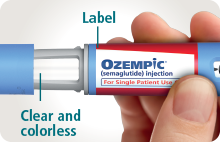
Prepare your pen
Check your Ozempic® pen
Read the label to check that your pen contains Ozempic®. Make sure that the Ozempic® medicine in your pen is clear and colorless.
2
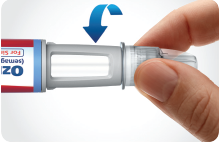
Attach a new needle
Tear off the paper tab. Push and turn the needle on until it is tight. Pull off both needle caps.
3
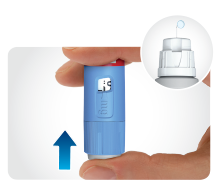
Check the Ozempic® flow with each new pen
Turn the dose selector until the dose counter shows the flow check symbol. Press and hold in the dose button until the dose counter shows 0. Make sure a drop appears at the needle tip.
4
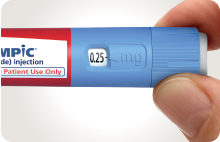
Give your injection
Select your dose
Turn the dose selector until the dose counter shows the dose you need to inject (0.25 mg or 0.5 mg for the red‑label pen, 1 mg for the blue‑label pen).
5
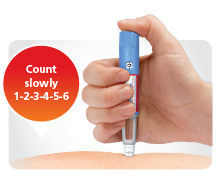
Inject your dose
Insert the needle into your skin. Press and hold down the dose button. After the dose counter reaches 0, slowly count to 6. Remove the needle from your skin.
6
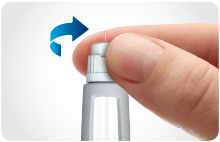
After your injection
Carefully remove the needle and place it in a sharps container. Put the pen cap back on the pen.
Using the pen, Ozempic® is injected under the skin of your abdomen, thigh, or upper arm. Do not inject into a muscle or vein- Change (rotate) your injection site with each injection. Do not use the same site for each injection. If you choose to inject in the same area, always use a different spot in that area
Your health care provider should show you how to take Ozempic® before you use it for the first time.
For more information about Ozempic® pen, see the Medication Guide and Instructions for Use or talk to your health care provider.
Missed a dose?
- If you miss a dose of Ozempic®, take the missed dose as soon as possible within 5 days after the missed dose
- If more than 5 days have passed, skip the missed dose, and take your next dose on your regularly scheduled day
How to store your Ozempic® pen
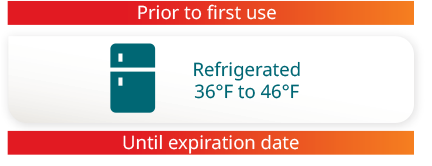
Store your new, unused Ozempic® pens in the refrigerator between 36°F to 46°F (2°C to 8°C).
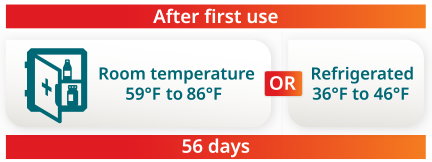
Store your pen in use for 56 days at room temperature between 59ºF to 86ºF (15ºC to 30ºC) or in a refrigerator between 36°F to 46°F (2°C to 8°C).

The Ozempic® pen you are using should be disposed of (thrown away) after 56 days, even if it still has Ozempic® left in it. Write the disposal date on your calendar.
Put your used Ozempic® pen and needle in an FDA-cleared sharps disposal container right away after use.
- If you do not have an FDA-cleared sharps disposal container, you may use a household container that is:
- made of a heavy-duty plastic
- can be closed with a tight-fitting, puncture-resistant lid, without sharps being able to come out
- upright and stable during use
- leak resistant
- properly labeled to warn of hazardous waste inside the container
Unused Ozempic® pens may be used until the expiration date (“EXP”) printed on the label, if kept in the refrigerator.

Do not freeze Ozempic®. Do not use Ozempic® if it has been frozen.
Keep Ozempic® away from heat and out of the light.
When stored in the refrigerator, do not store Ozempic® pens directly next to the cooling element.
Keep Ozempic® and all medicines out of the reach of children.
Keep the pen cap on when not in use.
Important Safety Information
Do not share your Ozempic® pen with other people, even if the needle has been changed. You may give other people a serious infection, or get a serious infection from them.
What is the most important information I should know about Ozempic®?
Ozempic® may cause serious side effects, including:
- Possible thyroid tumors, including cancer. Tell your health care provider if you get a lump or swelling in your neck, hoarseness, trouble swallowing, or shortness of breath. These may be symptoms of thyroid cancer. In studies with rodents, Ozempic® and medicines that work like Ozempic® caused thyroid tumors, including thyroid cancer. It is not known if Ozempic® will cause thyroid tumors or a type of thyroid cancer called medullary thyroid carcinoma (MTC) in people.
- Do not use Ozempic® if you or any of your family have ever had MTC, or if you have an endocrine system condition called Multiple Endocrine Neoplasia syndrome type 2 (MEN 2).
Do not use Ozempic® if:
- you or any of your family have ever had MTC or if you have MEN 2.
- you are allergic to semaglutide or any of the ingredients in Ozempic®. See symptoms of serious allergic reaction in “What are the possible side effects of Ozempic®?”.
Before using Ozempic®, tell your health care provider if you have any other medical conditions, including if you:
- have or have had problems with your pancreas or kidneys.
- have a history of diabetic retinopathy.
- are pregnant or breastfeeding or plan to become pregnant or breastfeed. It is not known if Ozempic® will harm your unborn baby or passes into your breast milk. You should stop using Ozempic® 2 months before you plan to become pregnant.
Tell your health care provider about all the medicines you take, including prescription and over-the-counter medicines, vitamins, herbal supplements, and other medicines to treat diabetes, including insulin or sulfonylureas.
What are the possible side effects of Ozempic®?
Ozempic® may cause serious side effects, including:
- inflammation of your pancreas (pancreatitis). Stop using Ozempic® and call your health care provider right away if you have severe pain in your stomach area (abdomen) that will not go away, with or without vomiting. You may feel the pain from your abdomen to your back.
- changes in vision. Tell your health care provider if you have changes in vision during treatment with Ozempic®.
- low blood sugar (hypoglycemia). Your risk for getting low blood sugar may be higher if you use Ozempic® with another medicine that can cause low blood sugar, such as a sulfonylurea or insulin. Signs and symptoms of low blood sugar may include: dizziness or Iightheadedness, blurred vision, anxiety, irritability or mood changes, sweating, slurred speech, hunger, confusion or drowsiness, shakiness, weakness, headache, fast heartbeat, and feeling jittery.
- kidney problems (kidney failure). In people who have kidney problems, diarrhea, nausea, and vomiting may cause a loss of fluids (dehydration), which may cause kidney problems to get worse. It is important for you to drink fluids to help reduce your chance of dehydration.
- serious allergic reactions. Stop using Ozempic® and get medical help right away if you have any symptoms of a serious allergic reaction, including swelling of your face, lips, tongue, or throat; problems breathing or swallowing; severe rash or itching; fainting or feeling dizzy; or very rapid heartbeat.
- gallbladder problems. Gallbladder problems have happened in some people who take Ozempic®. Tell your healthcare provider right away if you get symptoms which may include: pain in your upper stomach (abdomen), fever, yellowing of the skin or eyes (jaundice), or clay-colored stools.
The most common side effects of Ozempic® may include nausea, vomiting, diarrhea, stomach (abdominal) pain, and constipation.
What is Ozempic®?
Ozempic® (semaglutide) injection 0.5 mg, 1 mg, or 2 mg is an injectable prescription medicine used:
- along with diet and exercise to improve blood sugar in adults with type 2 diabetes.
- to reduce the risk of major cardiovascular events such as heart attack, stroke, or death in adults with type 2 diabetes with known heart disease.
It is not known if Ozempic® can be used in people who have had pancreatitis.
Ozempic® is not for use in people with type 1 diabetes.
It is not known if Ozempic® is safe and effective for use in children under 18 years of age.
Please click here for Prescribing Information and Medication Guide.



